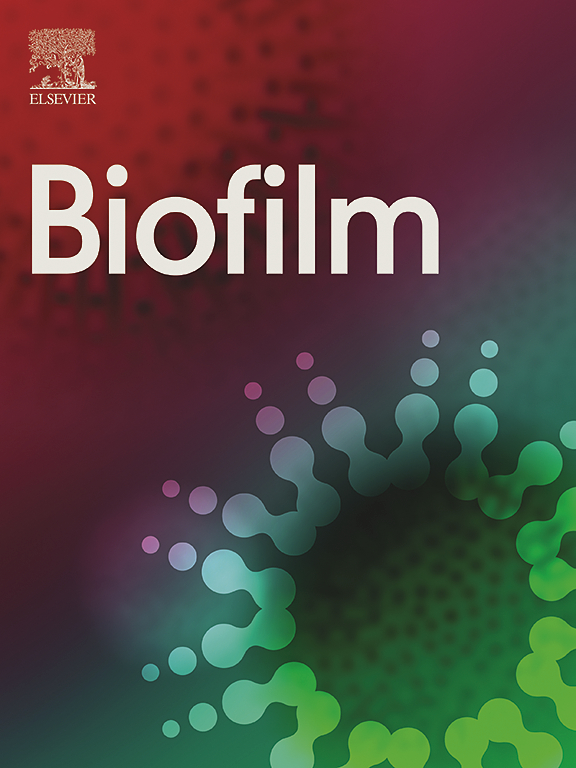Decoding the impact of interspecies interactions on biofilm matrix components
IF 4.9
Q1 MICROBIOLOGY
引用次数: 0
Abstract
Multispecies biofilms are complex communities where extracellular polymeric substances (EPS) shape structure, adaptability, and functionality. However, characterizing the components of EPS, particularly glycans and proteins, remains a challenge due to the diverse bacterial species present and their interactions within the matrix. This study examined how interactions between different species affect EPS component composition and spatial organization. We analyzed a consortium of four bacterial soil isolates that have previously demonstrated various intrinsic properties in biofilm communities: Microbacterium oxydans, Paenibacillus amylolyticus, Stenotrophomonas rhizophila, and Xanthomonas retroflexus. We used fluorescence lectin binding analysis to identify specific glycan components and meta-proteomics to characterize matrix proteins in mono- and multispecies biofilms. Our results revealed diverse glycan structures and composition, including fucose and different amino sugar-containing polymers, with substantial differences between monospecies and multispecies biofilms. In isolation, M. oxydans produced galactose/N-Acetylgalactosamine network-like structures and influenced the matrix composition in multispecies biofilms. Proteomic analysis revealed presence of flagellin proteins in X. retroflexus and P. amylolyticus, particularly in multispecies biofilms. Additionally, surface-layer proteins and a unique peroxidase were identified in P. amylolyticus multispecies biofilms, indicating enhanced oxidative stress resistance and structural stability under these conditions. This study highlights the crucial role of interspecies interactions in shaping the biofilm matrix, as well as the production of glycans and proteins, thereby enhancing our understanding of biofilm complexity.
解码物种间相互作用对生物膜基质成分的影响
多物种生物膜是细胞外聚合物质(EPS)形成结构、适应性和功能的复杂群落。然而,表征EPS的成分,特别是聚糖和蛋白质,仍然是一个挑战,因为存在不同的细菌种类和它们在基质内的相互作用。本研究考察了不同物种间相互作用对EPS成分组成和空间组织的影响。我们分析了四种细菌土壤分离物的联盟,这些细菌以前在生物膜群落中表现出各种内在特性:氧化微杆菌、解淀粉芽孢杆菌、嗜根寡养单胞菌和逆转录黄单胞菌。我们使用荧光凝集素结合分析来鉴定特定的聚糖组分,并使用元蛋白质组学来表征单物种和多物种生物膜中的基质蛋白。我们的研究结果揭示了不同的聚糖结构和组成,包括焦点和不同的氨基糖含聚合物,在单物种和多物种生物膜之间存在实质性差异。在分离条件下,M. oxydans产生半乳糖/ n -乙酰半乳糖胺网状结构,并影响多物种生物膜的基质组成。蛋白质组学分析显示,在逆行X.和解淀粉X.中存在鞭毛蛋白,特别是在多物种生物膜中。此外,在P. amylolyticus多物种生物膜中发现了表面层蛋白和独特的过氧化物酶,表明在这些条件下,P. amylolyticus生物膜的抗氧化性和结构稳定性增强。这项研究强调了物种间相互作用在形成生物膜基质中的关键作用,以及聚糖和蛋白质的产生,从而增强了我们对生物膜复杂性的理解。
本文章由计算机程序翻译,如有差异,请以英文原文为准。
求助全文
约1分钟内获得全文
求助全文

 求助内容:
求助内容: 应助结果提醒方式:
应助结果提醒方式:


